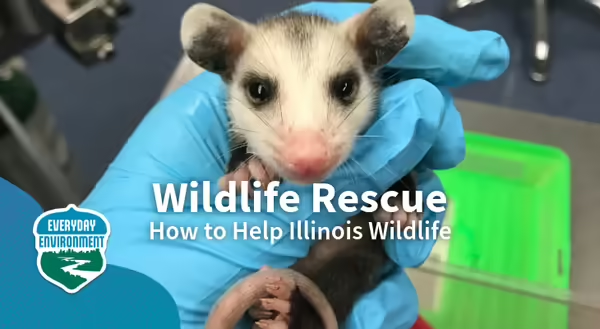
As our cities expand and natural habitats shrink, encounters with wildlife are becoming more frequent. Whether you are out in a local forest preserve or in your own backyard, there’s a chance you might stumble upon an injured, ill, or orphaned animal.
Does this animal need help?
Before intervening, it is best to observe the animal from a distance. Ask yourself:
- Is the animal obviously sick or injured?
- Did you witness it getting hurt or attacked?
- Are there insects on the animal, like flies and maggots?
- Is it lethargic or unresponsive?
- Is it a baby with another dead young or adult animal nearby?
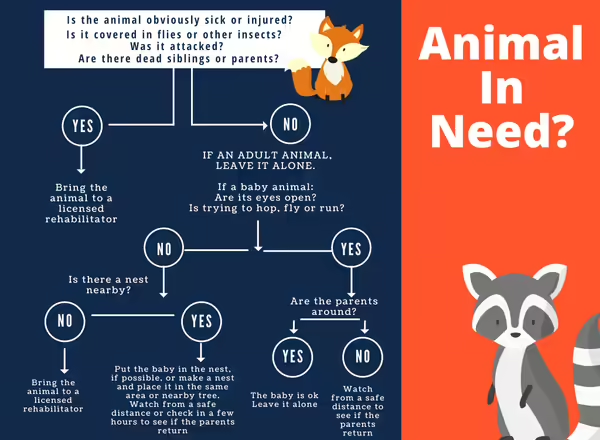
If you answered yes to any of these questions, the animal needs help and should be taken to a licensed rehabilitator as soon as possible. Adult animals that don’t flee when you attempt to approach are also a red flag and may be ill or too weak to move and should be brought into the clinic.
Use extreme caution when capturing adult wildlife, especially predatory animals like birds of prey, fox, coyote, bobcats, raccoons, and Virginia opossum. If unsure how to safely capture an animal, please contact a licensed rehabilitator for guidance. Some rehabilitators may assist with the capture or can direct you to a professional wildlife rescue service.
If you answered no, there are a few more considerations, whether it's an adult or a young animal.
What about baby animals?
Not all baby animals found alone are orphaned. If the baby has its eyes open and is uninjured, alert, and active, it is best to try to reunite it with its parents. Look for a nearby nest or den and gently return the baby to it, or make a nest and place it in the same area or a nearby tree. Then, observe from a distance to make sure a parent returns. This may take a whole day, so don’t get discouraged.
One exception would be a young Virginia opossum that is less than 7 inches in length. If a single opossum is found and is that small, it needs to go to a licensed rehabilitator, as its mother will not come back for it, and it is too small to survive on its own.
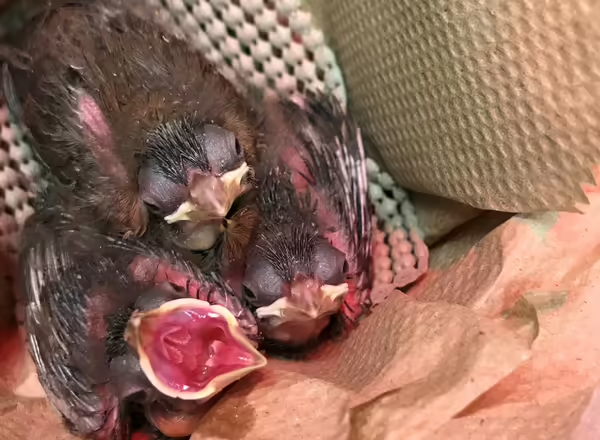
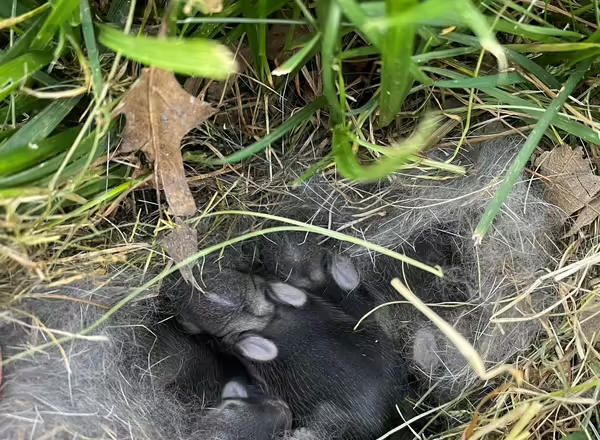
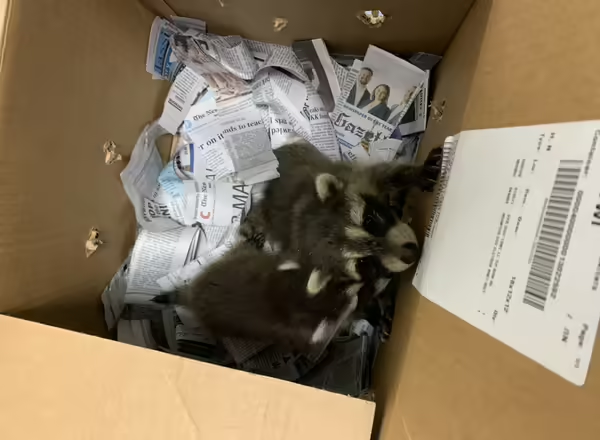
How to help safely
Before capturing any animal, identify a licensed wildlife rehabilitator in your area so you know where to take the animal. A full list for Illinois can be found at Wildlife Illinois.
DO NOT handle bats or skunks. Instead, call your local public health department or animal control for guidance.
Once a licensed rehabilitator has been found, collect the following items:
- A secure, well-ventilated container to transport the animal. (Example: Animal carrier, plastic tote, garbage can)
- Thick gloves (preferably leather work gloves or welding gloves)
- Towels, sheets, or blankets
- Safety glasses
Approach slowly, toss the linens over the animal, and carefully place the covered animal into the selected container. Make sure the container is secure so the animal cannot escape. Then, contact the licensed rehabilitator and transport the animal to them as soon as possible.
- DO NOT offer food or water.
- DO NOT delay transport.
- DO note the exact location where the animal was found (this is needed for release).
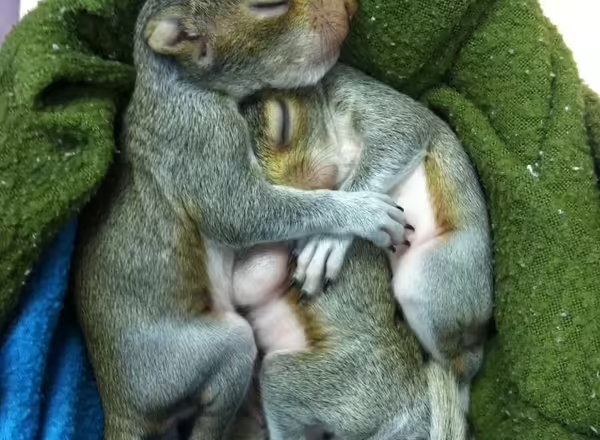
What animals come through the University of Illinois Wildlife Medical Clinic?
At the University of Illinois Wildlife Medical Clinic, we see just over 2,000 patients annually and around 120 different species. The most common patients include:
- Birds of prey
- Waterfowl
- Songbirds
- Eastern cottontails
- Squirrels
- Virginia opossums
- Raccoons
- Turtles
Why do these animals end up in the clinic?
- Hit by vehicle
- Window strike
- Exposure to poison or glue traps
- Cat or dog attack
- Trapped in man-made objects like sporting nets, fishing lines, and window wells
- Tree trimming during nesting season
- Frostbite
- Illness
- Orphaned or a young animal that is not thriving on its own
- Mistakenly rescued healthy animal (common with deer fawn and cottontails)
Ways to help wildlife
- To help turtles crossing a road, if it's safe to do so, slow down while driving, move over if wildlife is on the side of the road, and help turtles cross the road in the direction they were headed.
- Install commercially available, or DIY, bird-friendly window treatments.
- Prevention is the best method of dealing with pest species. Keep garbage cans tightly closed, store food in sealed containers, declutter to eliminate areas for pests to hide, and patch up any openings into your house.
- Choose humane pest control methods. Make sure you are selecting methods that target specific species and are not used broadly for a wide variety of animals. If chemicals must be used, make sure to use them as labeled on the bottle and regularly check the areas where you applied the chemicals.
- Keep cats indoors and check your yard for wildlife before letting dogs outside.
- Clean up thoroughly after outdoor activities, especially when fishing or hunting.
- Schedule tree trimming in late fall or winter to avoid disturbing nesting animals.
- Make your yard wildlife-friendly. Plant native species to support local ecosystems.
- Support conservation efforts like stream cleanups and habitat restoration.
With thoughtful action and informed choices, we can coexist with Illinois wildlife and ensure they thrive alongside us.
Resources to learn more
- University of Illinois Wildlife Medical Clinic
- Illinois Extension Wildlife
- National Wildlife Rehabilitators Association
- Wildlife Illinois - Orphaned Wildlife
- Licensed Wildlife Rehabilitator Map
This blog post was written by Sydney Oliveira, Wildlife Medical Clinic (WMC) Program Coordinator with the University of Illinois College of Veterinary Medicine.
About Everyday Environment
Everyday Environment is a series of blogs, podcasts, webinars, and videos exploring the intricate web of connections that tie us to the natural world. Want to listen to us chat about this topic? Check out the podcast episode on this topic to hear more from the Everyday Environment team about wildlife resources.
Was there something about this blog's topic we didn’t cover? See something cool in nature? Let us know! Send us your question or share your everyday nature observation with us at go.illinois.edu/EEconnect, and we may share it in a future blog or podcast.
Listen to the Podcast Get the Everyday Environment Newsletter Connect with Us